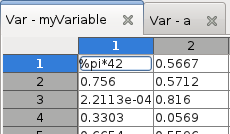
In this example that would be d:\lp_solve\lp_solve_5.5 Uncompress it to the same folder as for the sources, appended with lp_solve_5.5. Needed libraries and include files to link the sources with. It will create a directory structure lp_solve_5.5\extra\scilab\lpsolve in that folder.Īrchive lp_solve_5.5.2.11_dev.zip (Windows) or lp_solve_5.5.2.11_ (Unix) contains Make sure that the folder structure is kept. Uncompress it to a directory, for example d:\lp_solve. See further in this article.Īrchive lp_solve_5.5.2.11_scilab_ contains the sources to build sclpsolve. Scripts that can make things a lot easier. If you find that this involves too much work to solve an lp model then you can also work via higher-level
#SCILAB CONSTANT FULL#
So you have full control to the complete lpsolve functionality via the sclpsolve The whole lpsolve API is implemented with some extra's specific for Is written in C so it has maximum performance. Matrices can directly be transferred between Scilab and lpsolve in both directions. As such, it looks like lpsolve is fully integrated Lpsolve is callable from Scilab via an external interface. We will not discuss the specifics of Scilab here but instead refer the reader to the Specific applications (linear control, signal processing, network analysis, To support library development through ``toolboxes'' of functions devoted to.A useful tool distributed with Scilab is intersci which is a tool for building interface To have an open programming environment where new primitives are easilyĪdded.To provide a reasonable set of primitives which serveĪs a basis for a wide variety of calculations.To have data types which are varied and flexible withĪ syntax which is natural and easy to use.

The general philosophy of Scilab is to provide the following sort of ThisĪllows use of standardized packages and libraries in the interpreted environment Strings are also manipulated with the same syntax as ordinary matrices.įinally, Scilab is easily interfaced with Fortran or C subprograms. Particular, allows the on-line creation of functions. In addition Scilab supports a character string data type which, in For example, functions can be defined inside Scilab and passed as input Objects in Scilab and, thus, can be manipulated or created as other data Scilab has an open programming environment where the creation of functionsĪnd libraries of functions is completely in the hands of the user. The scicos toolbox allows the graphicĭefinition and simulation of complex interconnected hybrid systems. Integration of explicit and implicit dynamic systems can beĪccomplished numerically. Scilab provides a variety of powerful primitives for the analysis of Manipulating constant vectors and matrices. The syntax used for manipulating these matrices is identical to that used for Polynomials, polynomials matrices and transfer matrices are also defined and

Symbolic representation of complicated mathematical objects such as transfer This isĭone in Scilab by manipulating lists and typed lists which allows a natural People may want to manipulate rational or polynomial transfer matrices. Handling more complex objects than numerical matrices. Syntax is its ability to handle matrices: basic matrix manipulations such asĬoncatenation, extraction or transpose are immediately performed as well asīasic operations such as addition or multiplication. A few of them have been slightly modified forīetter compatibility with Scilab's interpreter. Interactively called by the interpreter) are of independent interest and most of Routines (which, strictly speaking, do not belong to Scilab but are Scilab is made of three distinct parts: an interpreter, libraries ofįunctions (Scilab procedures) and libraries of Fortran and C routines.
#SCILAB CONSTANT CODE#
It is freely distributed in source code format. Using lpsolve from Scilab Using lpsolve from Scilab Scilab?ĭeveloped at INRIA, Scilab has been developed for system control and signal


 0 kommentar(er)
0 kommentar(er)
